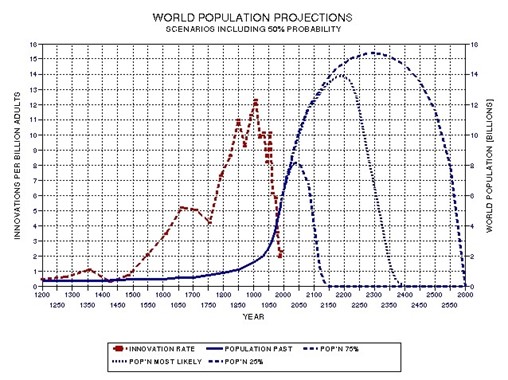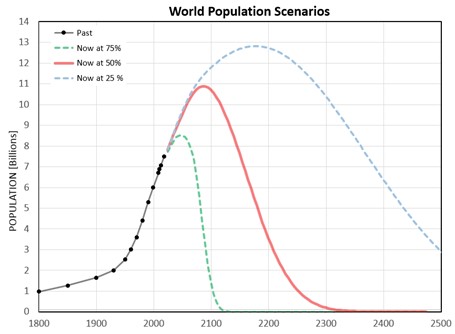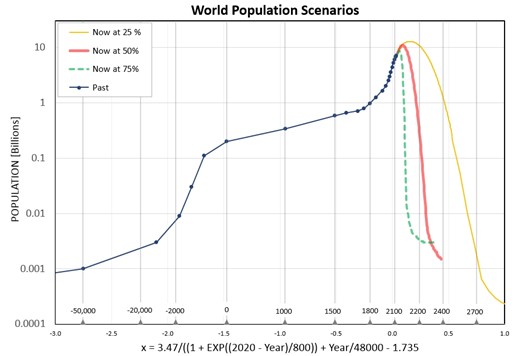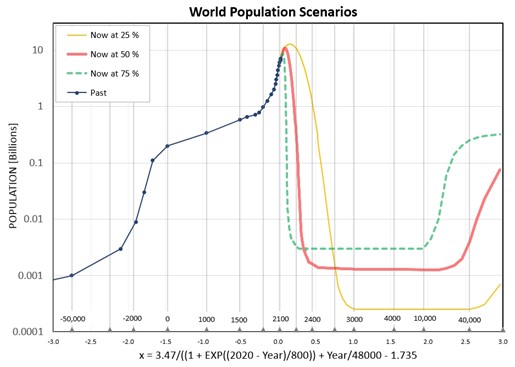
Man is a
portion of the inanimate universe come alive! We may be
the sole observer. Our intellect has revealed the nature
of our origin and our imagination allows us to speculate
upon the manner of our extinction – both as individuals
and as a species.
All present societies, like all past ones,
are doomed! Among the many civilizations in recorded history,
a median lifetime is approximately 250 years. I claim that
that’s how long it takes for the psychopaths to seize control
of a society, and for them and their cousins the sociopaths to
flourish and milk society to death. In the case of America, we
are now 247 years into an experiment with a form of
representative democracy, which places us near the median
longevity for civilizations. If we define Western Civilization
to have started in 1454, as some have suggested, we would now
be at the 567-year point – which is near the 75 % region for
civilization longevities. However we define our present
civilization we are “mature” in terms of historical
perspective, and it is not an outlandish position to suggest
that our demise is near.
We can’t count on political leadership to
save us. After all, the region of the United States with the
highest incidence of psychopaths is Washington, D.C. (Murphy,
2018).
I’ve achieved control
over my worrying about these matters. It’s not because I’m 84
years old, and near my end. It’s because the human species is
near its end, and things that used to matter will soon
not matter to anyone.
As Bertrand Russell wrote (1903): “... Such ... is the
world which Science presents for our belief. ... That man
is the product of causes which had no prevision of the end
they were achieving; that his origin, his growth, his
hopes and fears, his loves and his beliefs, are but the
outcome of accidental collocations of atoms; ... all the
noonday brightness of human genius [is] destined to
extinction in the vast death of the solar system, and …
the whole temple of man's achievement must inevitably be
buried beneath the debris of a universe in ruins..."
I am one of the first people to have presented a conjecture on
how to estimate the time of humanity’s end using Sampling
Theory (Gary, 1992, Ch. 7). It has become known by the
misleading name of The Anthropic Principle. It goes like this:
Suppose you’re asked to guess the length of a finite sequence
and you are allowed to fetch a sample at random. Suppose the
sequence consists of 100 elements, with each tagged #1 to
#100. There’s a 50% chance that an element drawn at random
will have a number tag between 1 and 50. The same applies to
drawing an element with a number tag between 51 and 100, or
even 26 and 75. By a similar reasoning there’s a 25 % chance
that an element drawn will have a number tag between 1 and 25,
etc. Because of this, it is possible to infer the likelihood
of the length of the sequence from a random drawing of just
one element. The rule for estimating the most likely total
sequence length is to simply double the number tag and state
that there’s a 50% chance that the sequence length is below
that number, and another 50% chance that it is above that
number. Similar statements can be made about the chance that
the total sequence has other lengths; e.g., there’s a 25 %
probability that the total sequence length exceeds 3 times the
random number tag, etc.

Figure 29.1. Graph from a 1992 publication (Gary,
1992) showing plausible future world population scenarios
corresponding to the 1992 world population being at the 75,
50 and 25th percentile locations of the complete
sequence, according to a sampling theory analysis. (The red
dashed trace can be ignored since it is a plot of
“innovation rate” which in my 1992 publication was treated
as having a possible correlation with population patterns.)
Now, consider the notion that the total
number of humans who will ever exist is a finite sequence. For
someone familiar with physics this may not seem outrageous,
e.g., space-time is a 4-D continuum. The concept of a “rigid”
universe was described by H. G. Wells in his book The Time
Machine (1895). Like a gigantic pinball machine, the
universe is governed by the laws of physics, i.e., F = ma, so
that all past and future configurations are inherent in any
one configuration.
Consider that we are now at a random
location in the finite sequence of human births. Everybody has
a number tag, which we can use birth dates to assign. Whether
we start assigning humans a number tag at 50,000 years ago, or
150,000 years ago, human populations were always so small
before about 50,000 years ago that we arrive at the same
approximate conclusion that humans now being born have a
number tag of about 62 billion. (This calculation was
performed for the date 1992, when I “discovered” the concept;
reasons for sticking with that date are given in my book Genetic Enslavement,
2021.) I concluded in 1992 that when plausible future world
population scenarios are used there’s a 25 % probability that
humanity will begin to undergo a population crash on or before
the year 2050! Similarly, there’s a 50 % probability that the
population crash will commence at about 2200. Finally, there’s
a 75 % probability that the population crash will commence
before approximately 2300 AD. The previous figure, Fig. 29.1,
shows shapes for the world’s population corresponding to the
three scenarios, as I derived them for a 1992 publication.
I have re-calculated population scenarios
using “today” as a reference for the sampling theory analysis,
since adopting a reference date is somewhat arbitrary. In
other words, for this re-analysis I ask the question “If we
are now, in 2020 (when this chapter was first written), at
specified percentile locations of a fixed sequence, how long
is the sequence, and how could plausible future population
scenarios place us at the 25th, 50th and
75th percentile locations?” The results of this
re-analysis are similar to my 1992 analysis, and they are
presented in Figure 29.2.

Figure 29.2. Three scenarios for future world
population, corresponding to our present time being
at the 75th, 50th and 25th
percentile of the entire human sequence.
To the extent that the above sampling
theory analyses are valid we can use them to support the
assertion that humanity will NOT adopt a winning path to
longevity, and that on timescales of a century or two the
psychopaths and sociopaths will milk civilization of all its
strength to survive. Recall that psychopaths resemble cancer
cells in having no prevision of the endings they bring about,
including theirs.
What might happen after the collapse? I
agree with Ord (2020) that some humans will survive after a
near-extinction event. This is shown in the next figure (Fig.
29.3), where the y-scale is logarithmic and the x-scale is a
sigmoid function that emphasizes “now time.”

Figure 29.3. Same data as plotted in the previous
figure but using a log scale for population and a “sigmoid
function” for representing dates.
Notice how I’ve shown the three population
declines with a “leveling out” shape following collapse. This
is meant to show that a final ending level will correspond to
what existed during the AE when only small tribes existed. The
lower levels for later collapse dates are meant to suggest
that the carrying capacity of Earth will depend on how
thoroughly the pre-collapse people ravaged the Earth and
exhausted resources.
If humans survive as a large number of
small tribes, with populations averaging 150 for example, they
might eventually recreate super-tribes. If this happens there
could be another Holocene-like population rise and a
consequent new version of civilization. Those of the second
civilization would surely be aware of the previous
civilization due to the physical ruins and still orbiting
artificial Earth satellites. Olaf Stapledon’s book Last
and First Men (1931) comes to mind. In it he suggested
that each resurrection of humanity from the ashes of a
previously failed one would differ so much that they should be
thought of as different species. Each resurrected species
exhibited in exaggeration a feature of our present species,
which was a clever writer’s trick for illustrating human
flaws.

Figure 29.4. Same data as plotted in the previous
figure but extended into the future to show a possible rise
of a second civilization (using a log scale for population
and a “sigmoid function” for representing dates). The date
range is 60,000 BC to 60,000 AD.
Figure 29.4 illustrates possible beginnings
of a second civilization for each of the three collapse
scenarios. Presumably the rise would have the same form as our
civilization: first a rise due to super-tribe creations,
followed by a rise when the super-tribes re-invent their
version of an industrial revolution, and later followed by a
rise after their version of a World War II explosion of
technology.
Is it possible that the rise and collapse
pattern will repeat forever? Each rise that produces a new
civilization would be a new version of the human species. The
long interval between civilizations could serve the purpose of
eliminating the deleterious mutations that were allowed to
accumulate during the existence of the civilization. Each
civilization could have its “noonday brightness in the sun,”
as Bertrand Russel would say.
Another possibility is that the population
collapse could be “complete,” leaving no humans to slowly
resurrect their mastery of Earth. This sober possibility can’t
be ruled out from what we now know. All of these speculations
make me sad, for they represent endings of either versions
of humanity or the entirety of humanity. Why
are so few people upset by these possibilities?
Why does everyone take for granted how
beautiful a place our Earth is? And how lucky we humans are
for living on it? It is shameful when people lack gratitude,
and behave in ways that are likely to deny future generations
being able to enjoy Mother Earth as we have! Shame, shame! We
have so much potential as a species, as H. G. Wells wrote
about in 1896 when he called attention to the possibility of
human improvement, achieved over long stretches of time, as
something “…to be lost or won by men, as they may have, or may
not have, the greatness of heart to consciously shape…” their
destiny.
I have a long-standing interest in
speculations about the presence in our galaxy of other
intelligent beings. On several occasions my professional
career in astronomy has connected with the search for
extraterrestrial intelligence, SETI. A compelling case for
humanity being the only intelligent species in the galaxy is
made by Ward and Brownlee (2000). A recent estimate of the
probability for the existence of ETI in our galaxy concludes
that we are probably alone (Sandberg, Drexler and Ord, 2018).
If it is true that we humans are uniquely privileged to be the
only intelligent species in our galaxy, what a shame it would
be for us to so casually and shamelessly ruin the planet, and
kill each other in wars, and live life without an appropriate
gratitude.
I believe that we have a “moral obligation”
to not squander something so rare and precious. Why, anyway,
should an individual care about the fate of his species? Why
should I care so much? In a few months, or years, I will die.
Eventually, so will my species. Regardless of any noonday
brightness that humanity may, or may not, achieve, I
nevertheless care!
As I give up hope for
humanity having a glorious future I recall a sad refrain by
the conservationist Robinson Jeffers (ca. 1925):
“Good news, oh beautiful planet, the accursed race of man is
not immortal.”
____________________________________________________________________
This
chapter is from the following book (Amazon link):
